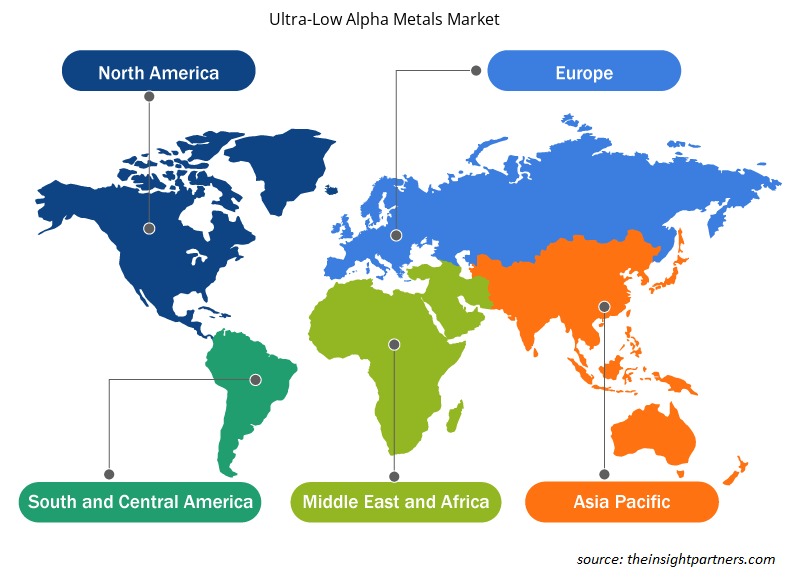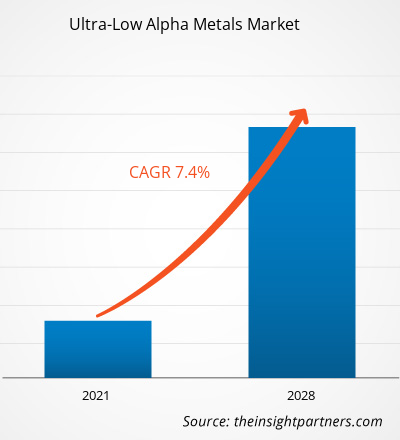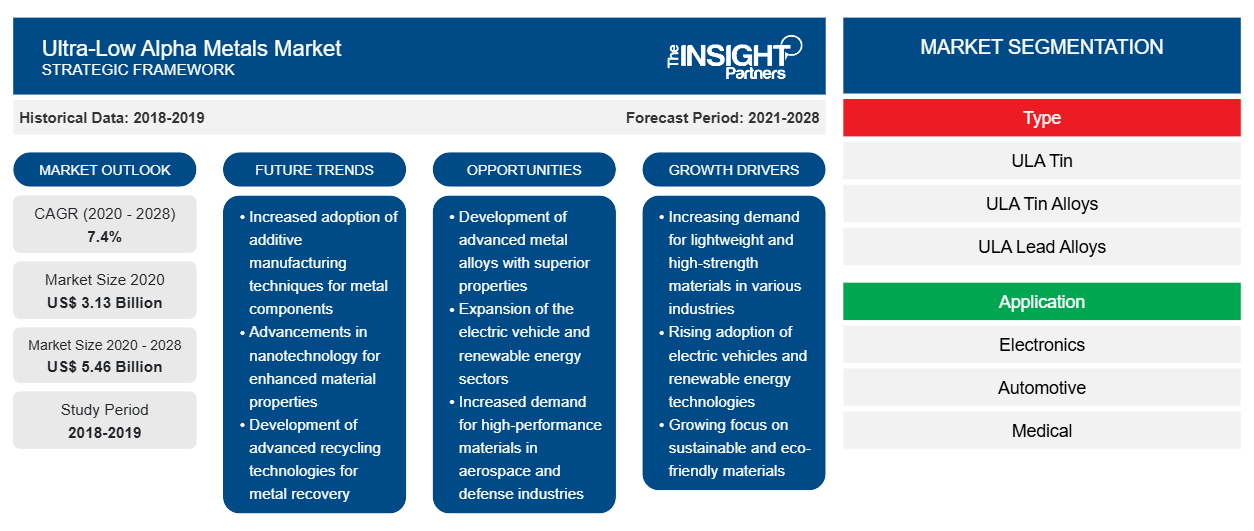[Forschungsbericht] Der Markt für Metalle mit ultraniedrigem Alphawert wurde im Jahr 2020 auf 3.125,00 Millionen US-Dollar geschätzt und soll bis 2028 5.461,78 Millionen US-Dollar erreichen; von 2021 bis 2028 wird ein durchschnittliches jährliches Wachstum von 7,4 % erwartet.
Ultra-Low-Alpha-Metalle werden in der Elektronikindustrie vor allem für Lötverbindungen verwendet. Die strengen staatlichen Vorschriften zur Verwendung gefährlicher Stoffe in elektronischen Geräten treiben das Wachstum des Marktes für Ultra-Low-Alpha-Metalle voran. Die Volatilität der Rohstoffpreise behindert jedoch das Marktwachstum.
Im Jahr 2020 hatte der asiatisch-pazifische Raum den größten Anteil am globalen Markt für Metalle mit ultraniedrigem Alphagehalt .Das Marktwachstum in der Region ist in erster Linie auf die Präsenz einer starken industriellen Basis mit namhaften Herstellern zurückzuführen. Die hohe Nachfrage nach Metallen mit ultraniedrigem Alpha-Gehalt aus Anwendungsbereichen wie Elektronik, Automobilbau und Medizin, unterstützt durch die stark wachsende industrielle Endverbraucherbasis, stimuliert das Wachstum des Marktes für Metalle mit ultraniedrigem Alpha-Gehalt in der Region.
Passen Sie diesen Bericht Ihren Anforderungen an
Sie erhalten kostenlos individuelle Anpassungen an jedem Bericht, einschließlich Teilen dieses Berichts oder einer Analyse auf Länderebene, eines Excel-Datenpakets sowie tolle Angebote und Rabatte für Start-ups und Universitäten.
-
Holen Sie sich die wichtigsten Markttrends aus diesem Bericht.Dieses KOSTENLOSE Beispiel umfasst eine Datenanalyse von Markttrends bis hin zu Schätzungen und Prognosen.
Auswirkungen der COVID-19-Pandemie auf den Markt für Metalle mit ultraniedrigem Alphagehalt
Die anhaltende COVID-19-Pandemie hat den Status des Chemie- und Materialsektors drastisch verändert und sich negativ auf das Wachstum des Marktes für Metalle mit ultraniedrigem Alpha-Gehalt ausgewirkt. Die Umsetzung von Maßnahmen zur Bekämpfung der Ausbreitung des neuartigen Coronavirus hat die Situation verschärft und die Nachfrage nach Industriemetallen und -materialien verringert. Der Betrieb der Industrie wurde durch die Pandemie beeinträchtigt, was letztlich den Lieferzyklus gestört und die Import-Export-Zölle erhöht hat. Die plötzliche Verzerrung der Betriebseffizienz und die Störungen der Wertschöpfungsketten werden auf die plötzliche Schließung nationaler und internationaler Grenzen und die vorübergehende Schließung von Produktionsstandorten aufgrund unbefristeter Lockdowns und vorübergehender Quarantänen zurückgeführt, die das Wachstum des Marktes während der Pandemie behindert haben. Die Einschränkungen der Lieferkette mit Volatilität bei den Rohstoffpreisen und der Beschaffung aufgrund der ersten Wochen des Lockdowns haben die industriellen Produkte und Prozesse gestört. Auch der Fokus auf die Just-in-time-Produktion ist ein weiterer besorgniserregender Faktor, der das Marktwachstum behindert. Da die Volkswirtschaften jedoch planen, ihre Aktivitäten wieder anzukurbeln, wird erwartet, dass die Nachfrage nach Metallen mit ultraniedrigem Alpha-Gehalt in den kommenden Jahren weltweit steigen wird. Die steigende Nachfrage nach fortschrittlichen Industriematerialien aufgrund des Wachstums verschiedener Endverbrauchsbranchen wie Elektronik, Luft- und Raumfahrt und Verteidigung, Automobilindustrie, Medizin und Telekommunikation wird voraussichtlich auch das Wachstum des Marktes in den kommenden Jahren vorantreiben. Darüber hinaus werden erhebliche Investitionen namhafter Hersteller in die Weiterentwicklung bleifreier Legierungen mit ultraniedrigem Alpha-Gehalt das Wachstum des Marktes für Metalle mit ultraniedrigem Alpha-Gehalt im Prognosezeitraum vorantreiben.
Markteinblicke
Zunehmende Bedenken hinsichtlich Soft-Error-Problemen befeuern Wachstum auf dem Markt für Metalle mit ultraniedrigem Alpha
Die steigende Nachfrage nach Produkten mit hoher Dichte und niedrigem Stromverbrauch hat das Konzept der Reduzierung der Abmessungen und Betriebsspannungen moderner elektronischer Geräte vorangetrieben. Die ständige Skalierung komplementärer Metalloxid-Halbleiter-Gerätetechnologien hat zu einer Miniaturisierung und Verringerung der Betriebsspannung der Gerätetransistoren geführt. Das Konzept hat jedoch sowohl aus technologischer als auch aus materialtechnischer Sicht neue Herausforderungen mit sich gebracht. Ein solches Problem ist der Soft Error, die vorübergehende Fehlfunktion des Geräts, die durch die Strahlung hochenergetischer Alphateilchen verursacht wird. Eine der Hauptquellen der Alphateilchenstrahlung sind die Lote, die in großem Umfang zum Verbinden von Komponenten in der Verpackung eingesetzt werden. Daher hat die wachsende Besorgnis über das Soft Error-Problem zu einer erhöhten Nachfrage nach Metallen mit ultraniedrigem Alpha geführt.
Typ-Einblicke
Der globale Markt für Metalle mit ultraniedrigem Alpha-Gehalt ist nach Typ in ULA- Zinn, ULA -Zinnlegierungen, ULA- Bleilegierungen, ULA -bleifreie Legierungen und andere unterteilt. Das Segment der bleifreien ULA -Legierungen und anderer war im Jahr 2020 marktführend. Mit den wachsenden Investitionen in Forschungs- und Entwicklungsaktivitäten entwickeln die Hersteller fortschrittliche Produktformen, die den spezifischen Anforderungen der Branche gerecht werden können. In ähnlicher Weise haben die Hersteller bleifreie ULA -Legierungen eingeführt, die einen deutlich geringen Bleianteil ( d. h . 0,1 %) oder überhaupt kein Blei enthalten. Die Nachfrage nach bleifreien Lötlegierungen mit ultraniedrigem Alpha-Gehalt steigt aufgrund der wachsenden Sorge um die Umwelt.
Anwendungseinblicke
Basierend auf der Anwendung ist der globale Markt für Metalle mit ultraniedrigem Alpha in die Bereiche Elektronik, Automobil, Medizin, Telekommunikation und andere unterteilt. Das Segment Elektronik war im Jahr 2020 Marktführer. Bei elektronischen Anwendungen ist es zwingend erforderlich, Legierungen und Metalle mit ultraniedrigem Alpha einzusetzen. Die Verwendung von Metallen mit ultraniedrigem Alpha hilft, Fehlfunktionen aufgrund von Softfehlern in elektronischen Geräten zu vermeiden. Darüber hinaus führt die deutliche Reduzierung der Gerätegröße sowie die Installation von Lötmaterialien in der Nähe der empfindlichen Stellen in elektronischen Geräten zu einem Bedarf an Metallen mit ultraniedrigem Alpha. Bei der Herstellung von Unterhaltungselektronik steigt die Nachfrage nach Metallen mit ultraniedrigem Alpha.
Zu den wichtigsten Akteuren auf dem globalen Markt für Metalle mit ultraniedrigem Alphagehalt zählen unter anderem MITSUBISHI MATERIALS Corporation, Teck Resources Limited, Advanced Manufacturing Services (AMS) Ltd, Pure Technologies, Honeywell International Inc., DUKSAN Hi-Metal Co., Ltd und MacDermid Alpha Electronics Solutions.
Bericht-Spotlights
- Fortschrittliche Branchentrends auf dem Markt für Metalle mit ultraniedrigem Alphawert unterstützen die Akteure bei der Entwicklung wirksamer langfristiger Strategien
- In Industrie- und Entwicklungsländern angewandte Strategien für Unternehmenswachstum
- Quantitative Analyse des Marktes für Metalle mit ultraniedrigem Alpha von 2019 bis 2028
- Schätzung der weltweiten Nachfrage nach Metallen mit ultraniedrigem Alpha
- PEST-Analyse zur Veranschaulichung der Wirksamkeit der in der Branche tätigen Käufer und Lieferanten
- Aktuelle Entwicklungen zum Verständnis des wettbewerbsorientierten Marktszenarios
- Markttrends und -aussichten sowie Faktoren, die das Wachstum des Marktes für Metalle mit ultraniedrigem Alpha vorantreiben und bremsen
- Unterstützung im Entscheidungsprozess durch Aufzeigen von Marktstrategien, die das kommerzielle Interesse untermauern und zum Marktwachstum führen
- Die Größe des Marktes für Metalle mit ultraniedrigem Alphawert an verschiedenen Knotenpunkten
- Detaillierte Übersicht und Segmentierung des Marktes sowie der Dynamik der Ultra-Low-Alpha-Metalle
- Größe des Marktes für Metalle mit ultraniedrigem Alpha in verschiedenen Regionen mit vielversprechenden Wachstumschancen
Regionale Einblicke in den Markt für Metalle mit ultraniedrigem Alpha
Die regionalen Trends und Faktoren, die den Markt für Metalle mit ultraniedrigem Alpha-Gehalt im gesamten Prognosezeitraum beeinflussen, wurden von den Analysten von Insight Partners ausführlich erläutert. In diesem Abschnitt werden auch die Marktsegmente und die Geografie für Metalle mit ultraniedrigem Alpha-Gehalt in Nordamerika, Europa, im asiatisch-pazifischen Raum, im Nahen Osten und Afrika sowie in Süd- und Mittelamerika erörtert.

- Erhalten Sie regionale Daten zum Markt für Metalle mit ultraniedrigem Alpha
Umfang des Marktberichts zu Metallen mit ultraniedrigem Alpha
| Berichtsattribut | Details |
|---|---|
| Marktgröße im Jahr 2020 | 3,13 Milliarden US-Dollar |
| Marktgröße bis 2028 | 5,46 Milliarden US-Dollar |
| Globale CAGR (2020 - 2028) | 7,4 % |
| Historische Daten | 2018-2019 |
| Prognosezeitraum | 2021-2028 |
| Abgedeckte Segmente |
Nach Typ
|
| Abgedeckte Regionen und Länder |
Nordamerika
|
| Marktführer und wichtige Unternehmensprofile |
|
Marktteilnehmerdichte für Metalle mit ultraniedrigem Alpha-Gehalt: Auswirkungen auf die Geschäftsdynamik verstehen
Der Markt für Metalle mit ultraniedrigem Alpha-Gehalt wächst rasant. Dies wird durch die steigende Nachfrage der Endverbraucher aufgrund von Faktoren wie sich entwickelnden Verbraucherpräferenzen, technologischen Fortschritten und einem größeren Bewusstsein für die Vorteile des Produkts vorangetrieben. Mit der steigenden Nachfrage erweitern Unternehmen ihr Angebot, entwickeln Innovationen, um die Bedürfnisse der Verbraucher zu erfüllen, und nutzen neue Trends, was das Marktwachstum weiter ankurbelt.
Die Marktteilnehmerdichte bezieht sich auf die Verteilung der Firmen oder Unternehmen, die in einem bestimmten Markt oder einer bestimmten Branche tätig sind. Sie gibt an, wie viele Wettbewerber (Marktteilnehmer) in einem bestimmten Marktraum im Verhältnis zu seiner Größe oder seinem gesamten Marktwert präsent sind.
Die wichtigsten Unternehmen, die auf dem Markt für Metalle mit ultraniedrigem Alpha-Gehalt tätig sind, sind:
- Mitsubishi Materials Corporation
- Teck Resources Limited
- Advanced Manufacturing Services (AMS) Ltd
- Pure Technologien
- Honeywell International Inc.
Haftungsausschluss : Die oben aufgeführten Unternehmen sind nicht in einer bestimmten Reihenfolge aufgeführt.

- Überblick über die wichtigsten Akteure auf dem Markt für Metalle mit ultraniedrigem Alpha
Globaler Markt für Metalle mit ultraniedrigem Alpha
Nach Typ
- ULA- Dose
- ULA Zinnlegierungen
- ULA Bleilegierungen
- ULA bleifreie Legierungen und andere
Nach Anwendung
- Elektronik
- Automobilindustrie
- Medizin
- Telekommunikation
- Andere.
Firmenprofile
- MITSUBISHI MATERIALS Corporation
- Teck Resources Limited Resources Limited
- Advanced Manufacturing Services (AMS) LtdAMS) Ltd
- Pure Technologien
- Honeywell International Inc.
- DUKSAN Hi-Metal Co., Ltd Hi-Metal Co., Ltd
- MacDermid Alpha Electronics Lösungen Alpha Electronics Solutions
- Historische Analyse (2 Jahre), Basisjahr, Prognose (7 Jahre) mit CAGR
- PEST- und SWOT-Analyse
- Marktgröße Wert/Volumen – Global, Regional, Land
- Branchen- und Wettbewerbslandschaft
- Excel-Datensatz
Aktuelle Berichte
Erfahrungsberichte
Grund zum Kauf
- Fundierte Entscheidungsfindung
- Marktdynamik verstehen
- Wettbewerbsanalyse
- Kundeneinblicke
- Marktprognosen
- Risikominimierung
- Strategische Planung
- Investitionsbegründung
- Identifizierung neuer Märkte
- Verbesserung von Marketingstrategien
- Steigerung der Betriebseffizienz
- Anpassung an regulatorische Trends























 Kostenlose Probe anfordern für - Markt für Metalle mit ultraniedrigem Alpha-Gehalt
Kostenlose Probe anfordern für - Markt für Metalle mit ultraniedrigem Alpha-Gehalt